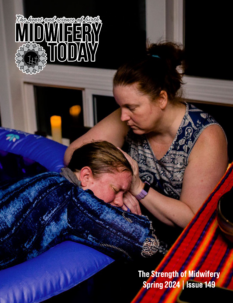
What Do Doulas Really Do?
Editor’s note: This article first appeared in Midwifery Today, Issue 125, Spring 2018.
Subscribe to Midwifery Today Magazine
Introduction
In the 1980s and early 1990s several seminal events occurred that affected me deeply: the publication of John Kennell’s and Marshall and Phyllis Klaus’s first papers and books showing the positive impact on birth outcomes when women receive continuous labor support by a kind encouraging lay person (Sosa et al. 1980; Klaus et al. 1986); the publication of Michel Odent’s book Birth Reborn, which eloquently described the instinctual and labor-promoting behavior of laboring women when they feel free, safe, and undisturbed (1984); and a qualitative study that I conducted, which showed that women remember their first childbirths vividly, accurately, and poignantly for at least 15 to 20 years (Simkin 1991 and Simkin 1992). The long-term satisfaction of these women was associated much more with how they recalled being treated by their caregivers than with whether their births were easy, difficult, or complicated.
These events, combined with my own early experience as a childbirth educator attending the labors of some of my students, helped me see how different women are during labor than how they are in daily life. The more I witnessed this, the more curious I became. Having now attended hundreds of births as a doula, I have thought a lot about the unique role of doulas compared to others who attend births. I want to share those thoughts in this paper.
Research on Doulas’ Impact on Birth Outcomes
As doulas have increased in numbers, they have drawn the attention of researchers around the world, who have compared birth outcomes when women had continuous labor support in any form (nurse, midwife, partner, family, friends, doula) or no support (Bohren et al. 2017).
My question is: What is it about the doula that improves outcomes more than any other person who provides labor support? The opening sentence of this paper, which defines the birth doula very simply, leaves us with the question, “How and why does a doula make such a difference?” To find out, let’s explore the role of the doula in more detail.
The Changing State of Mind of the Laboring Woman and the Role of the Doula
Women in labor are in a fluid state of consciousness, which shifts as they respond to the changing sensations and demands of labor. For example, at various times they may exhibit any of the following states of mind: alert, thoughtful, sociable, upset, angry, frightened, calm, withdrawn, quiet, active, vocal, dependent, overwhelmed, tense, peaceful, instinctive, or more.
In early labor, they are likely to behave in their “usual ways”—being conversational, being social, asking and answering questions, making decisions, using humor, etc. They are engaging their neocortex—the thinking/reasoning part of the brain—which is the site of most higher brain functioning. As labor advances and intensifies, they begin to recognize that they have no control over the labor, their affect changes, and they may express self-doubt, fatigue, fear, or dread. This change in mood indicates that older, more “primitive” parts of the brain—the limbic system and brain stem—are activated. These parts govern instinct, mood, basic emotions (such as fear, pleasure, anger), drives related to self-preservation (such as hunger, sex, care of offspring), and basic physiology (such as blood pressure, pulse, sleep/wake states, breathing), and more. If the laboring woman feels safe and supported, she stops trying to control the labor and lets her body take over. If she feels alone, criticized, endangered, frightened, or threatened, she goes into “fight or flight” mode, and produces catecholamines (stress hormones—epinephrine and others) that interfere with maternal and fetal well-being and labor progress (Buckley 2015).
In active labor, women are vulnerable and less engaged with those around them, focus inward, use few words, and behave instinctually. They may rock, vocalize with moans or repeated phrases (“I can do it, I can do it”), count, or tap—in a rhythm. With good support and little disturbance, they find their own best way to get through the contractions. I call this their unplanned “spontaneous ritual.” They are in an altered state (sometimes referred to as “the zone,” “la la land,” “labor land”). Ina May Gaskin says the woman lets her “monkey do it,” (Gaskin 2003, 253) referring to the parts of the brain—the limbic system and brain stem—that govern feelings of well-being and guide instinctual behavior, including the birth process. When in labor, women deal with intense emotions, along with physical sensations of pain and extreme effort. Sometimes the doula or a confident partner is an essential part of the ritual, using a soothing tone of voice and murmuring or vocalizing along with her, or silently rocking with her or holding or stroking her. These actions allow release of oxytocin, which enhances contractions along with feelings of well-being. (If there is a disturbance, or a person comes in or asks questions, the laboring mother may snap out of the ritual temporarily, and then resume it after the interruption has passed.)
If, however, the laboring woman feels “unsafe”—from being ignored, criticized, distracted, or treated disrespectfully—or if problems develop for mother or baby—she may be too frightened or distressed to release control. This can lead to “fight or flight” mode, which causes release of high levels of stress hormones (epinephrine, norepinephrine, and others) that may interfere with oxytocin production, labor progress, and fetal well-being (Buckley 2015).
It seems to me that a major part of our role as doulas is to facilitate the laboring woman’s instinctive ability to labor and to help her feel safe to let go. If we doulas are to help, we must “speak to her condition”; in other words, recognize and match her state of mind. Rather than using words, explanations, and detailed discussions, doulas are likely to sit quietly close by; entrain ourselves to the birthing person—mirroring or modeling rhythmic movements, rocking and swaying; make eye contact; touch; or vocalize in a calm soothing voice. I call this “being in the woman’s rhythm.” We communicate at an instinctual level and, because we are there continuously and have no clinical role, we focus mainly on the emotional state and physical comfort of the birthing woman and can recognize and respond to changes in progress and mood better than if we go in and out of the room. As needed, of course, we also assist with positions, movements, comfort measures, and strategies to improve labor progress.
Research Findings on Continuous Labor Support by Doulas and Others
The most recent Cochrane Review of 26 randomized controlled trials of continuous support in labor (compared to no labor support) reported that when women had continuous support of any kind—from loved ones, midwives, or other hospital staff or doulas—they were less likely to:
- have an epidural or other regional analgesia to manage pain.
- use any type of pain medication (including narcotics).
- give birth by c-section.*
- give birth with vacuum extraction or forceps.
- give birth to a baby with a low Apgar score at five minutes after birth.
- be dissatisfied with or negatively rate their childbirth experience”* (Bohren et al. 2017).
Support from a loved one or hospital staff did not affect these outcomes, but when women had a trained doula, they were:
- 39% less likely to have a cesarean.
- 35% less likely to report their childbirth experience negatively.
- 15% more likely to have a spontaneous vaginal birth (no forceps or vacuum extraction) (Childbirth Connection 2017).
How Do Doulas Complement the Role of the Partner?
Doulas are often asked why they are needed if the laboring woman has a loving partner who plans to be involved. The two roles are very different. Both contribute in different ways. The partner knows the laboring woman better than anyone who is at the birth—her hopes, fears, worries, history, values, dreams. Also, the partner loves her more. Depending on the partners’ personal qualities, they may find the birth invigorating and exciting or frightening and exhausting. They may feel competent and helpful, or not. The doula has training and experience from attending many births. Doulas learn the role that the couple want the partner to play and what may be needed. Partners may or may not want to play an active role. The doula may guide, feed, and relieve the partner when a break is needed; reassure, educate, assist, remind, and show the partner ways to help; and, sometimes, replace the partner. Of course, laboring women often benefit from more than one person for touch, eye contact, and physical support.
How Do Doulas Complement the Role of the Midwife or Nurse?
The clinical role of care provider prioritizes the goals of survival and good health with no lasting harm. It includes continuing observation of mother, baby, and labor progress; and, if a problem arises, the care provider employs measures to correct the problem and minimize the undesired effects of the solution. The emotional state of the mother is another priority, but of lower importance.
Mental alertness, broad knowledge, and clear, quick thinking are important qualities of the care provider, who functions at the highest level of the central nervous system—the neocortex. This is the part of the brain where thoughts, evaluation, interpretations, and judgment take place. The communication style of the caregiver often does not fit that of the laboring woman, who may be functioning at the level of the limbic system—where feelings like stress, fear, well-being, and dependency predominate over reason and judgment—or her brainstem may be activated, where instincts for survival (“fight or flight”) dictate behavior.
The dilemma is that two people—caregiver and client—are trying to communicate at different levels. For example, the caregiver may ask questions during contractions or discuss facts, care strategies, decisions, “science,” risks, or benefits in the same tone and words that would be used in a prenatal visit in the office when the woman is composed, thoughtful, and engaged. In labor she may respond with, “Do whatever you have to do,” or “I just want it to be over!” (I often wonder if it is possible to carry on a rational, calm conversation and make truly informed decisions when in the throes of active labor! This is a topic for another time!)
The doula offers a unique form of labor support that is distinctly different from care by midwives, nurses, or birth assistants. Although there is some crossover, doulas and clinical personnel complement each other; they do not duplicate what they offer the laboring woman and partner.
The biggest differences between doulas and midwives or nurses are these: First, doulas have no clinical role in care—procedures, decisions, or advice. Clinical care providers constantly monitor maternal and fetal well-being, contraction pattern, and labor progress, as well as maternal emotions and behavior. Their main goals are survival of mother and baby without any health problems. Doulas do not have clinical responsibilities or the skills or education to perform a clinical role, which leads to the second big difference in the contributions of doulas and clinical care providers.

Parts of the brain and their basic functions. The doula’s continuous support, by addressing basic subconscious human reactions (limbic system and brain stem), may be a key element to explain how and why doulas improve birth outcomes. When one feels safe and cared for, physiological functions are facilitated.
Because doulas are likely to be with the woman continuously (except for bathroom breaks) from early in labor until an hour or two after the birth, they can track the dynamics in the room, observe the behavior and emotional states of the birthing woman and supporters, and adapt their care accordingly. They know when to be upbeat or reassuring, when to model patience and confidence, and when to guide and educate the woman or her partner. When the parents are discouraged, demoralized, or exhausted, doulas empathize, change the circumstances, become more directive, or help the parents adjust to a change in care plan, if needed. The doula’s role is challenging to describe, because the role is adapted to the birthing individual and the situation, moment by moment.
Doulas have the luxury of focusing on “matching the mood” of the laboring woman and can communicate with her in a variety of nonverbal ways, as her moods and her labor change. At the same time the doula is aware of the larger picture—environment, interactions among those in attendance, labor progress, and how all these may be affecting the laboring woman. Thus, the doula can truly be with her as she progresses through the shifts in emotions and physical sensations that occur during labor, birth, and afterward.
Conclusion: Possible Explanation for How Doulas Improve Birth Outcomes
In conclusion, the answer to the question, “What do doulas really do?” is complicated. You’ve read my long answer (this whole article!). My short answer is that doulas do whatever it takes for as long as it takes to see the family through a safe and satisfying birth, as defined by that family.
We do know this. When doulas are present during labor:
- Oxytocin flows and causes effective contractions, more spontaneous births, and a parent who is ready (eager) to nurture and nourish the infant—who is alert, curious, and lovable.
- Stress hormones are reduced, thus reducing maternal and fetal distress and slow labor.
Their non-clinical role fosters and facilitates the physiologic process and improves birth outcomes.
References:
- Bohren, MA, et al. 2017. “Continuous Support for Women during Childbirth.” Cochrane Database of Syst Rev 2017(7): 1–162.
- Buckley, S. 2015. Hormonal Physiology of Childbearing: Evidence and Implications for Women, Babies, and Maternity Care. New York: Childbirth Connection.
- Childbirth Connection. 2017. Research and Evidence. Retrieved on Jan. 13, 2018. childbirthconnection.org/giving-birth/labor-support/research-evidence.
- Gaskin, IM. 2003. Ina May’s Guide to Childbirth. New York: Bantam Books.
- Klaus, MH, JH Kennell, and PH Klaus. 1993. Mothering the Mother: How a Doula Can Help You Have a Shorter, Easier, and Healthier Birth. Reading, MA: Addison Wesley.
- Klaus, MH, et al. 1986. “Effects of social support during parturition on maternal and infant morbidity.” BMJ 293(6547): 585–87.
- Odent, M. 1984. Birth Reborn: How Childbirth Can Be What Women Want It to Be—and How Mothers and Babies Both Benefit. New York: Pantheon Books.
- Simkin, P. 1991. “Just Another Day in a Woman’s Life? Part I. Women’s long-term perceptions of their first birth experiences.” Birth 18(4): 203–10.
- Simkin, P. 1992. “Just Another Day in a Woman’s Life? Part 2. The nature and consistency of women’s long-term memories of their first birth experiences.” Birth 19(2): 64–81.
- Sosa, R, et al. 1980. “The effect of a supportive companion on perinatal problems, length of labor, and mother-infant interaction.” NEJM 303(11): 597–600.

 Penny Simkin, PT, is a physical therapist who has specialized in childbirth education since 1968. She estimates she has prepared over 14,000 women, couples and siblings for childbirth, and is a co-founder of DONA International. Today her practice consists of childbirth education, birth counseling, and writing, combined with a busy schedule of conferences and workshops. Penny and her husband, Peter, have four grown children, eight grandchildren, three grandchildren-in-law, and a pug named Lola.
Penny Simkin, PT, is a physical therapist who has specialized in childbirth education since 1968. She estimates she has prepared over 14,000 women, couples and siblings for childbirth, and is a co-founder of DONA International. Today her practice consists of childbirth education, birth counseling, and writing, combined with a busy schedule of conferences and workshops. Penny and her husband, Peter, have four grown children, eight grandchildren, three grandchildren-in-law, and a pug named Lola.
















